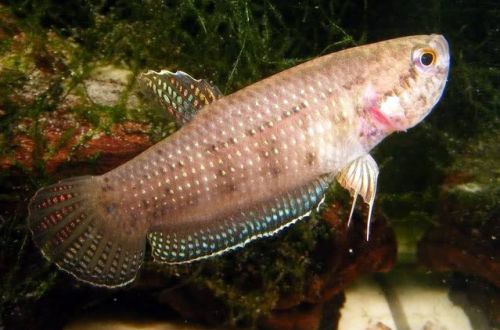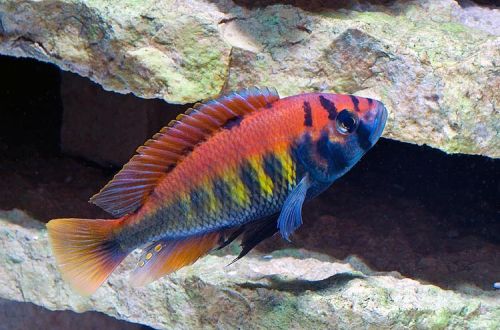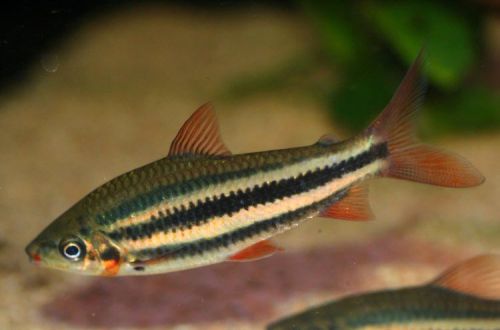
Betta Edith
Betta Edith or Cockerel Edith, scientific name Betta edithae, belongs to the Osphronemidae family. Named after explorer Edith Korthaus, a naturalist and explorer who was involved in the discovery of many fish species on the island of Borneo. Not too demanding in the home aquarium, but the need to maintain low pH and dGH values can be difficult for beginner aquarists.

Contents
Habitat
It comes from Southeast Asia from the Indonesian part of the island of Borneo. It was originally discovered in the Barito River Delta in the province of South Kalimantan, but later the natural habitat was expanded to almost the entire island. Currently, research is ongoing, a number of biologists believe that the discovered samples from different places are, although very close, but still different species.
In nature, they inhabit swampy reservoirs and artificial channels between oil palm plantations, the bottom of which is covered with a thick layer of fallen leaves, branches, snags and other plant material. The water has a rich brown color due to the high concentration of dissolved humic acids and other tannins released as a result of the decomposition of plant organic matter.
Brief information:
- The volume of the aquarium – from 70 liters.
- Temperature – 20-27°C
- Value pH — 5.0–7.0
- Water hardness – 1–5 dGH
- Substrate type – any dark
- Lighting – subdued
- Brackish water – no
- Water movement – little or no
- The size of the fish is 5–6 cm.
- Food – any food
- Temperament – peaceful
- Content – in a pair or group together with other species
Description
Adult individuals reach a length of 5–6 cm. This species is characterized by mild sexual dimorphism. Males are somewhat larger, and in the body pattern there are dark horizontal stripes on a light background, stretching from head to tail. Iridescent blue hues are visible on the fins and tail. The females are smaller and the coloration is more uniform silvery or light grey.
Food
In nature, they feed on insects, their larvae, crustaceans and other invertebrates. In the home aquarium, alternative foods will usually be accepted as soon as they are found to be edible. The recommended daily diet includes dry (flakes, granules), frozen and live foods.
Maintenance and care, arrangement of the aquarium
The optimal size of the aquarium for one couple or a small group starts from 70-80 liters. The design uses a large number of floating plants, such as salvinia, riccia, tropical lilies from the genus Nymphaeum and others, as well as shade-loving varieties, such as anubias, cryptocorynes, mosses and ferns, placed at the bottom. Indispensable elements of decor are also natural driftwood and leaves of some trees, pre-soaked to avoid floating. The leaf litter serves not only for decoration, but also affects the composition of the water, making it similar to that in which fish live in nature, due to the release of tannins. Read more in the article “Which tree leaves can be used in an aquarium.”
Successful long-term maintenance of Edith Cockerel is impossible without providing a stable aquatic environment within an acceptable range of temperatures and hydrochemical values. The balance of the biological system of the aquarium is maintained through the implementation of regular maintenance procedures (replacing part of the water with fresh water, removing waste) and the smooth operation of equipment, primarily the heating and filtration systems.
Keep the tank closed so that under the lid there is a layer of warm, moist air necessary for the normal functioning of the labyrinth organ in Betta fish.
Behavior and Compatibility
Peaceful calm fish, gets along well with other non-aggressive species of comparable size. It is worth avoiding a settlement along with too large fish, next to which Petushki may feel in danger.
Intraspecific relationships are built on the rivalry of males for position in the hierarchy and the attention of females. Competition is manifested in a “demonstration of strength”, but skirmishes barely come to the fore, so they can be maintained in groups of different sexes or male / female pairs.
Breeding / breeding
Under favorable conditions, spawning is not uncommon. With the onset of the mating season, the alpha male and female form a temporary pair. Spawning is accompanied by a kind of “hugging dance”, during which the fish wrap themselves around each other and release eggs at the moment of climax. All fertilized eggs subsequently end up in the male’s mouth, where they will stay for the entire incubation period of 9–16 days. Such gestation of eggs is characteristic of many representatives of the Betta fish group and provides better preservation of the brood compared to the usual throwing of eggs on the ground or among plants.
During gestation, the male seeks to hide in a quiet corner of the aquarium or in some kind of shelter. If he is constantly disturbed, then he may accidentally swallow part of the eggs or even the entire masonry.
The fry appear fully formed and ready to accept micro-feed. These can be specialized products for juvenile aquarium fish, Artemia nauplii are a good choice.
Fish diseases
The cause of most diseases is unsuitable conditions of detention. A stable habitat will be the key to successful keeping. In the event of symptoms of the disease, first of all, the quality of the water should be checked and, if deviations are found, measures should be taken to correct the situation. If symptoms persist or even worsen, medical treatment will be required. Read more about symptoms and treatments in the Aquarium Fish Diseases section.





